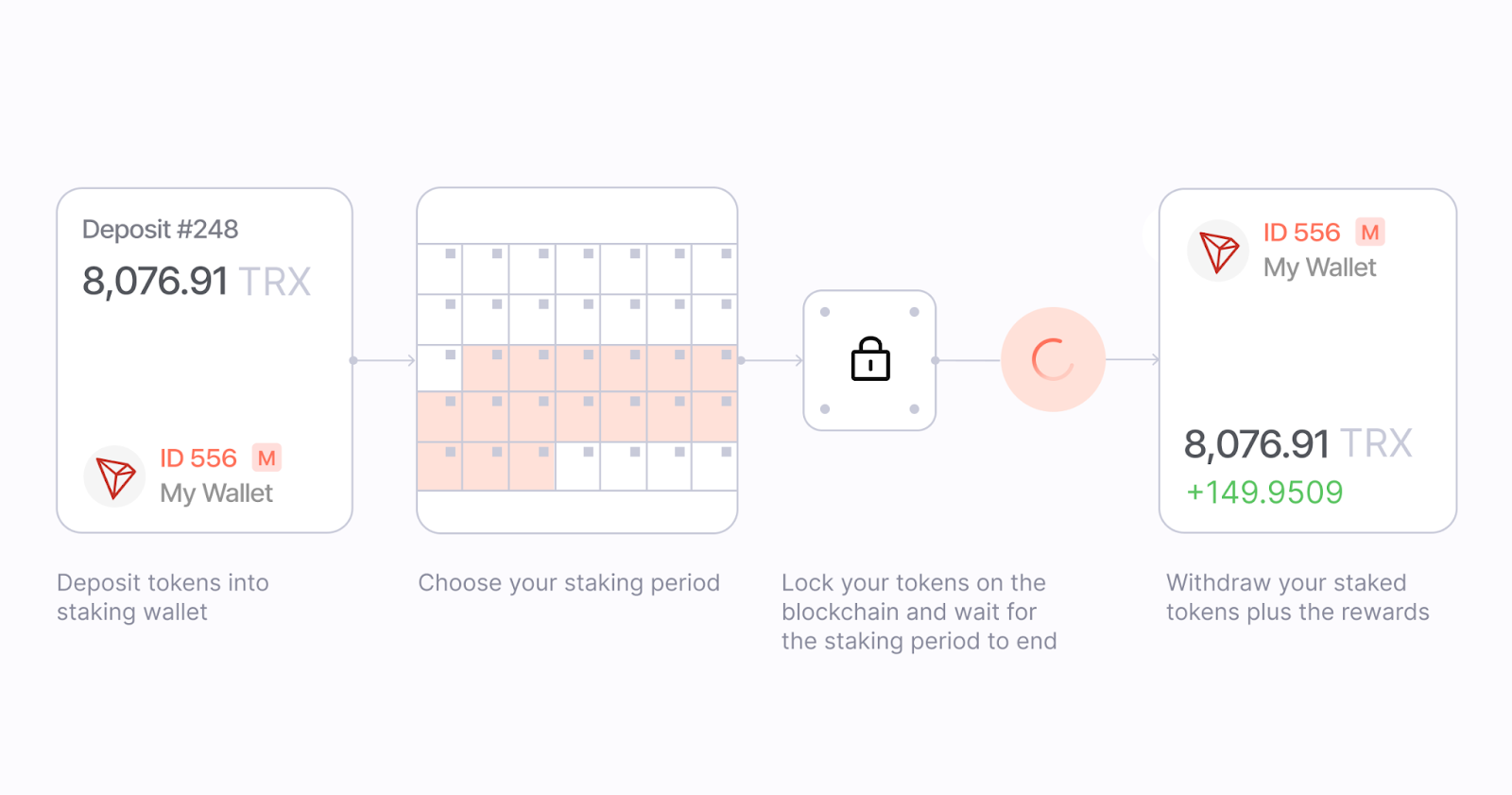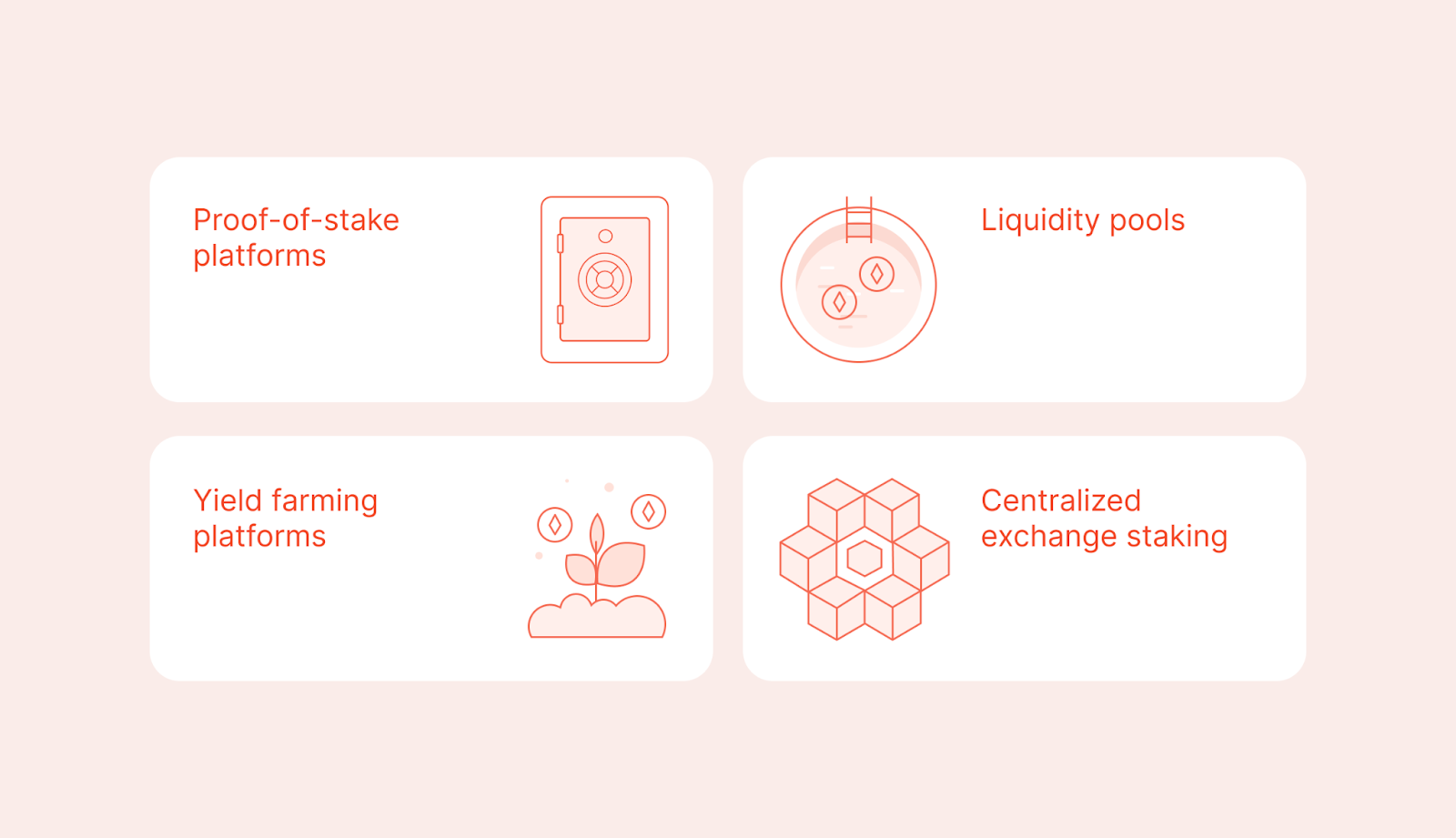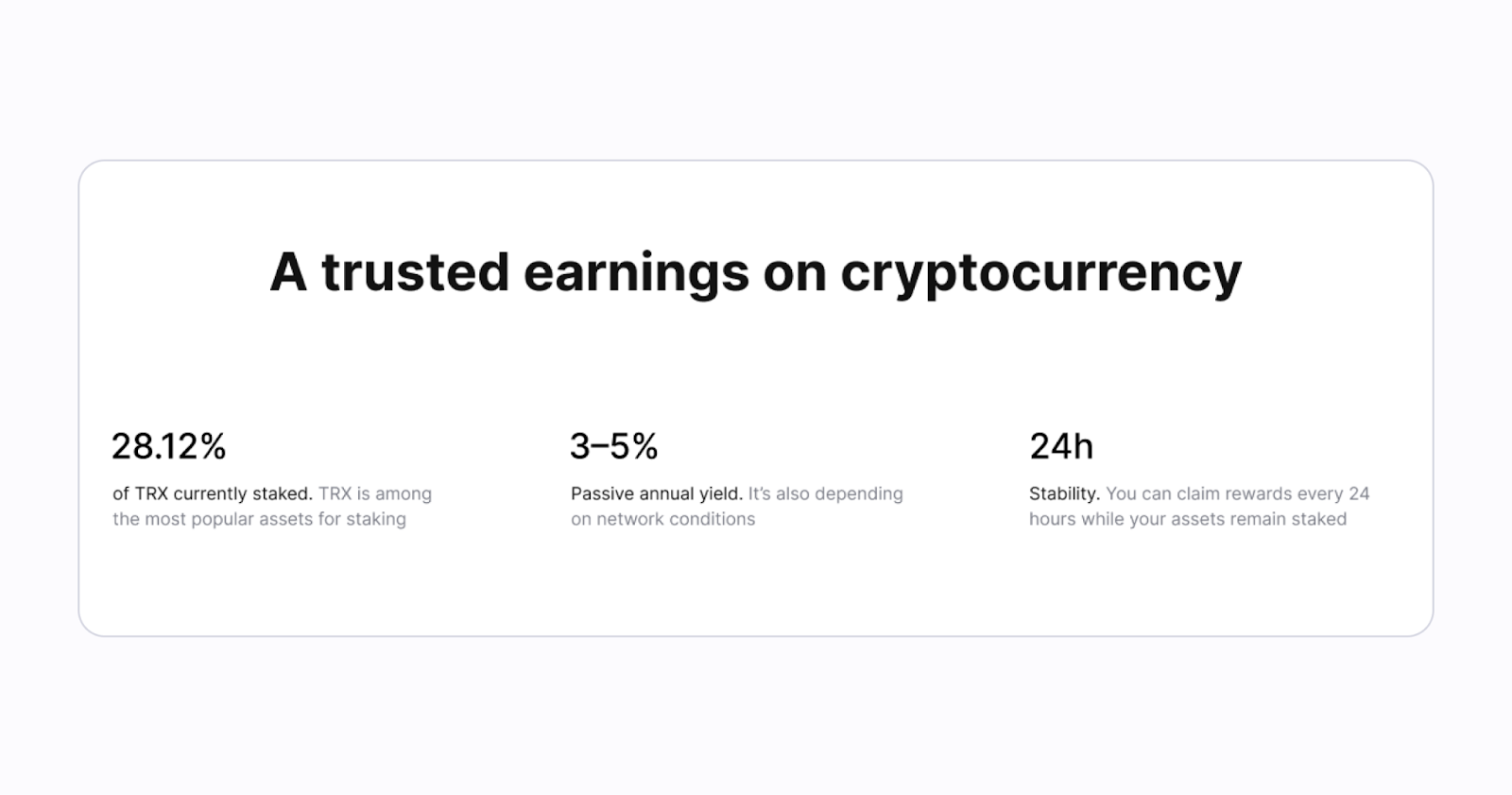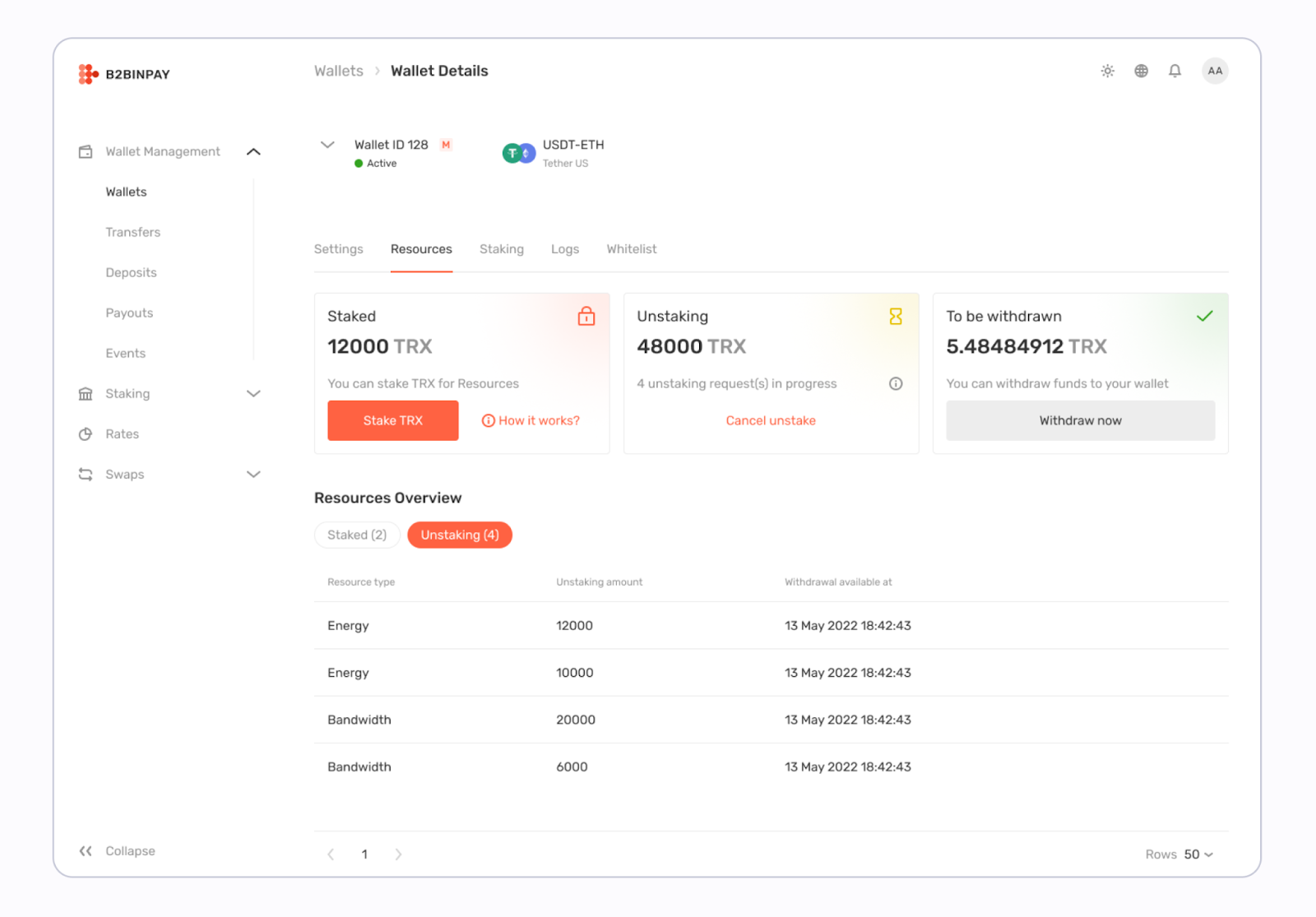What is cryptocurrency staking?
Crypto staking entails ‘locking up’ your tokens on a blockchain to earn rewards. The tokens you lock on the blockchain will validate transactions and create new blocks. After the agreed staking period, you’ll be given additional tokens as a reward.
Staking is an effective way to earn passive income on your digital assets. You’ll also contribute to the security and efficiency of your blockchain network. You can stake via crypto exchanges or by running your own validator node.
Should you stake cryptocurrency?
Cryptocurrency staking enables you to earn passive income, but it requires careful thought. The main benefit is that you’ll grow your crypto assets over time instead of letting them sit unused. It also feels good to contribute to the effectiveness of the blockchain network you use to transact.
When staking, note that you wouldn’t be able to access your staked assets for a specific period. Lockup periods range from 30 to 90 days or even longer. Hence, you should only stake assets that you wouldn’t need to access in the near term.
How does crypto staking work?
Staking coins works only on proof-of-stake blockchains, which utilize a consensus algorithm to validate transactions. In contrast, proof-of-work blockchains rely on competition between miners to validate transactions.
- In simpler terms, proof-of-stake blockchains rely on cordial agreements between crypto stakers to validate transactions, while proof-of-work blockchains rely on crypto miners competing to solve puzzles to validate transactions.
Because proof-of-stake blockchains rely on consensus, you can contribute your tokens to participate in the consensus process. The blockchain will use your staked coins to help validate new transactions, and you’ll receive staking rewards in exchange for your contributions.

The staking process
Deposit tokens into staking wallet > Choose your staking period > Lock your tokens on the blockchain > Wait for the staking period to end > Withdraw your staked tokens plus the rewards
Types of staking

Common types of staking include:
- Direct staking. This type involves running your own validator node on a blockchain. It requires technical knowledge and significant hardware resources, but the benefit is that you’ll retain all staking rewards instead of paying a commission to a third party that runs the validator node on your behalf.
- Exchange staking. Many crypto exchanges allow users to stake their crypto assets. The crypto exchange operates the validator node on behalf of users, and rewards are distributed proportionally. Crypto exchanges typically charge a fee of 1% to 25% of the staking rewards.
- Liquid staking. This creative staking format gives you ‘representative tokens’ after staking your original tokens. During the staking period, you can exchange the representative tokens for the real ones you staked, plus the accrued interest, or spend the representative tokens on other activities. It’s a workaround that gives you liquidity after staking tokens, unlike traditional staking, in which your assets are locked up throughout the staking period.
What is proof-of-stake?
Proof-of-stake is a blockchain consensus mechanism in which crypto holders validate transactions on their blockchain. Token holders can deposit their tokens to validate transactions and, in return, receive network rewards.

How the proof-of-stake consensus mechanism works
- Validators stake some tokens
- An algorithm randomly selects the next validator on the blockchain.
- The chosen validator creates the next block to be added to the network.
- The other non-selected validators verify the newly created block.
- The new block is added to the blockchain.
- The validator receives transaction fees as the reward.
Crypto holders can run validator nodes (specialized servers) on a proof-of-stake blockchain. The blockchain uses an algorithm to determine which validator node will verify new transactions. The higher your staked assets, the higher the chances that the algorithm will choose your validator node to verify new transactions.
- Imagine a community bank run by its members. Instead of having a specific person in charge of verifying and recording transactions, members are randomly selected each day to perform this task. The more money a member deposits, the higher their chances of being chosen to verify transactions.
- At the end of each quarter, the bank’s profits are distributed to its members based on the volume of transactions they have verified and recorded. This is a simple analogy of how proof-of-stake blockchains work.
Proof-of-stake blockchains require a minimum amount of tokens to run a validator node. Many individual users can’t meet this minimum requirement, so they pool their assets together to run validator nodes, known as pooled staking. Crypto exchanges and staking protocols let you contribute your tokens to validator nodes and begin receiving rewards when they are due.
Delegated proof-of-stake
Delegated proof-of-stake is an advancement of the traditional proof-of-stake mechanism. It involves token holders voting for some delegates, who then validate transactions on their behalf. Think of it as a representative democracy where people vote for their representatives in the federal government.
The advantages of the delegated proof-of-stake mechanism include:
- Scalability. It’s easier to scale the network when there are fewer validators to wrangle with.
- Efficiency. A consensus can be reached more quickly when there are fewer validators participating in the process. Hence, transactions are processed faster.
- Governance. Token holders can vote for delegates who represent their best interests, or remove those who do not, thereby establishing an incentive to follow the blockchain’s rules.
A common criticism is that delegated proof-of-stake can lead to a concentration of power among delegates. However, this issue can be prevented by adding more delegates if needed.
What are slashing penalties in crypto?
In any system that relies on consensus, there’s a mandatory need to penalize players who violate the rules. Slashing is the mechanism by which violators are penalized in the staking process.
If a validator fails to fulfill their responsibilities, such as by going offline for an extended period, they may lose some or all of their staked tokens. This slashing disincentivizes malicious behavior by validators and ensures a secure network.
Are there any risks in staking crypto?
All forms of investing involve risk, including staking. The risks of staking include:
- Market volatility. Crypto markets are highly volatile, meaning price fluctuations can reduce the value of your staked crypto assets over time. Despite receiving more crypto as a staking reward, your holdings might be worth less than before the staking period because of broader market conditions.
- Slashing penalties. If your third-party validator violates the blockchain’s rules, your assets could be lost due to slashing penalties. This risk highlights the importance of selecting a trusted platform when staking assets.
- Counterparty risk. When entrusting your tokens to a third party, such as a cryptocurrency exchange, there’s a risk that your assets may be mismanaged or lost due to poor security practices. However, you can mitigate this risk by selecting a reputable staking platform with robust security features.
- Opportunity cost. In traditional staking, your assets are locked for the agreed staking period. These assets won’t be available for other trading activities, which can be a lost opportunity.
Is it possible to unstake assets?
Yes, you can unstake your assets before the end of the agreed staking period. However, that will mean forgoing the complete reward and only claiming a part of it.
Some platforms have a waiting period before which you can unstake assets. It’s generally safe to unstake assets, but there's a risk of losing out on potential staking gains.
Crypto staking as a service
Staking is technically complex to manage on your own. To avoid technical headaches, you can use a staking-as-a-service platform to validate transactions on your behalf and distribute the rewards when due. The platform runs the validator nodes with your tokens and distributes the rewards according to the amount you’ve staked. It’ll take a commission of the staking rewards for its service.
B2BINPAY is an ideal staking-as-a-service platform to choose. Our platform makes it easy to stake tokens and receive your rewards at the end of the staking period. We’re a trusted, secure platform for staking Tron (TRX) tokens, and you’ll receive rewards directly into your crypto wallet.Staking rewards

Staking rewards
Staking rewards vary depending on the blockchain, amount staked, and the agreed staking period. Typically, the larger the staked assets and the longer the staking period, the more rewards you can expect. Rewards are calculated on an annualized basis and can range from a few percent to as high as 20% or even more.
B2BinPay offers TRX staking with annual yields of 3% to 5%, depending on network conditions. You can conveniently stake your tokens and accrue passive income via our platform.
How to start
- Registration. Create an account on B2BINPAY. The process is straightforward.
- Stake. Choose the amount of TRX tokens you want to lock on the blockchain.
- Claim rewards. Withdraw your tokens and rewards directly into your crypto wallet at the end of the staking period.

FAQs
Can I lose my crypto if I stake it?
In rare cases, staked assets can be lost to hacks or malicious validators who violate the blockchain’s rules and incur slashing penalties. However, in most cases, you can stake crypto safely and withdraw your rewards when due.
Which crypto is best for staking?
TRX is one of the best tokens to stake due to its stable and relatively high rewards. The Tron blockchain is growing fast, creating an increasing need for validators to maintain network security. You can stake your TRX tokens to participate in the validation process and earn rewards.
How much can I earn by staking Bitcoin?
Staking rewards vary depending on market conditions, but you can generally earn 1% to 5% annually by staking Bitcoin.
Is staking crypto safe?
Yes, you can safely stake crypto and earn rewards. However, some risks exist, such as tokens losing value due to broader crypto market conditions.



.svg)







